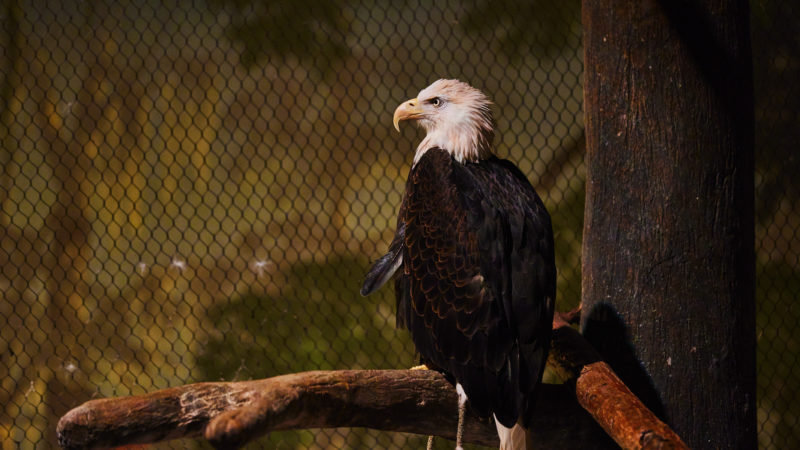
Published December 2, 2021
Article by: Wonders of Wildlife Marketing
Six years ago, Riser, the American bald eagle, soared high over the treetops in North Carolina. The wind rustled his feathers, his eyes scanned the ground below. He slowed for his landing, diving towards black lines on the horizon. With talons outstretched, Riser clasped onto the power line, an event that would change his life forever.
Power lines are a significant cause of death for raptors like Riser. Each year, it is estimated that 0.9 to 11.6 million birds perish due to electrocution. While it may not seem like it, Riser is one of the lucky ones. He survived. If he had connected with the power line at a different angle, if the power line were more powerful, if his feathers were wet instead of dry, he would be one of 11.6 million. Instead, the good folks at Cape Fear Raptor Center in North Carolina arrived at the scene and changed this trajectory.
Riser was not in the clear yet. It is recorded that birds may survive the initial injury, but perish later on from complications. One such complication had stricken Riser, the severe soft tissue damage in his left wing. Due to the extent of the injury, the necessary decision was made for his wing to be amputated at the wrist, leaving him flightless. His days of soaring above the treetops of North Carolina were over, and Riser was deemed non-releasable. His options were limited. Where is a flightless bird to go? Fortunately, Wonders of Wildlife heard about Riser and decided to take him in.
Life at WOW
Riser traveled over 1,000 miles to arrive at his new home in Springfield, Missouri. He was skittish around people. After having his wing necessarily amputated the last time he was with humans, one can sympathize with Riser’s distrust. According to lead keeper, Olivia Rose, over time and with lots of training, Riser allows his keepers to enter his enclosure to provide enrichment, training, and tasty snacks. His favorite food is trout, a throwback to his wild days in North Carolina. He enjoys hopping down from his perch and fishing them out from the pond in his enclosure. It still takes Riser a while to adapt to new stimuli, such as noises, people, and enrichment items, however his keepers have made extraordinary progress, and they are able to coach Riser through these fears with some operative conditioning.
Now, two years after his arrival, Riser is a whole new bird. He navigates his enclosure with ease, utilizing small hops to reach his perch. He surveys his land and enjoys scrutinizing passerbys. Upper Swamp at Wonders of Wildlife is a bit different from North Carolina, but, as long as there are trout in his pond and treats from his keepers, Riser can adapt. He’s proven that much!
Eagles Make A Comeback
American bald eagle rehabilitation and protection efforts, like with Riser, have been years in the making. Only 60 years ago the species was on the brink of extinction. Our Nation’s conservationists fought hard to preserve this bold and majestic creature, not just as the national bird of the United States, but as a symbol of freedom, strength, and courage.
In the 1940s, the government implemented the Bald and Golden Eagle Protection Act to prohibit people from disturbing bald eagles, shooting them, or plundering their nests. However, by the early 1960s, less than 500 nesting pairs of wild bald eagles remained in the lower 48 states due to a combination of habitat destruction, poaching, and contamination of fish, the bald eagle’s primary food source, from a specific agricultural pesticide known to pollute water. In 1972 this act was amended to further protect bald eagles from pollution and poaching. Of course, our Nation wanted to see its symbol live to soar another day, so in 1978 the species was officially placed on the endangered species list. This allowed the public to see how much the bald eagle population was threatened and allowed the federal government to take further steps to help the birds. Several decades of protection and proactive conservation efforts have allowed the population to soar to more sustainable levels today. As of 2021, there are now over 71,000 nesting pairs of bald eagles and an estimated 316,700 individual birds throughout the USA!
Riser: A Success Story
We recently celebrated Riser’s second anniversary at Wonders of Wildlife. Everyday guests pass by his enclosure in Upper Swamp and don’t think twice about his journey or the conservation efforts that preserved his species. As an ambassador animal, Riser is here to change that. The Senegalese conservationist, Baba Dioum, said it best, “In the end we will conserve only what we love; we will love only what we understand; and we will understand only what we are taught.” Today and everyday, we thank Riser for teaching us, so that we may gain understanding of the arduous journey of conservation.


No comments:
Post a Comment